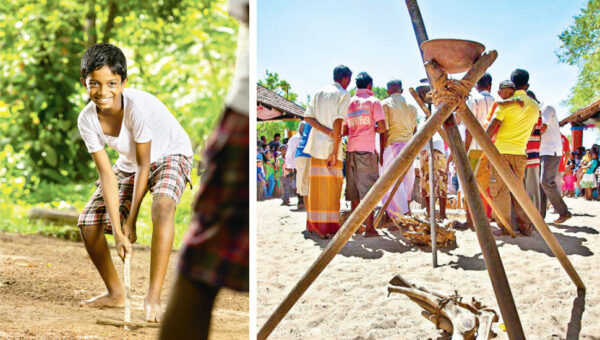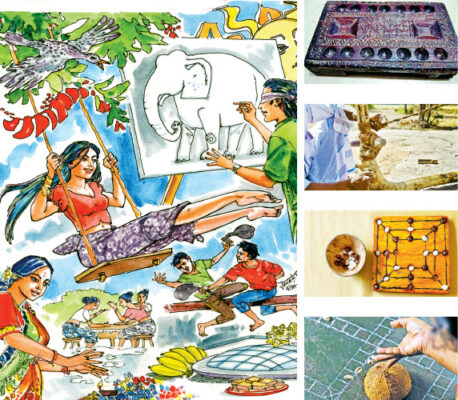Sri Lankan Folk Games-By Ama H. Vanniarachchy

Source:Ceylontoday
The Sinhala New Year season is a season of happiness, relaxation and fun. New clothes, food, and games are a part of the New Year celebrations. Families get together and engage in various traditional games and sports during their leisure time. Among these games there are a variety of them suitable for different age groups. Some are indoor games whilst some are outdoor games. However today, these traditional games are fading away. Many do not engage in them. Most of the younger generation only know these games by name. Hence, we will present to you some interesting and lesser known facts about our traditional games.
According to historical texts the history of sports and games in Sri Lanka goes back to the historic period, which means to the Anuradhapura Period. Based on these details it seems that there were a few number of games that were mainly or only for royals and the elite while there were a large number of games that the public and the royals both had in common.
Games that were popular among the public are called folk games.
Although these folk games could be played during any time of the year, they were commonly played during the April New Year season. People were relaxed during the New Year season and were enjoying success after the harvest. It was like a time of leisure after a long year of hard work. Hence, families and friends would unite and engage in these games. Most of them are played outdoors and require a large space, which was abundant in a typical Sri Lankan village. The equipment used was made out of fruits, seeds, wood, and natural materials such as reed or dried leaves.
Folk games and sports could be categorised into four main types;
– Indoor
– Outdoor
– Adventurous
– Religious
Indoor games
– Gal kireema
– Iratu hangeema
– Pancha dameema
– Dolaha dameema
– Olinda keliya (Muthu keliya)
– Neranchi
– Pol nelima
Outdoor games
– Wala kaju gaseema
– Lunu paneema
– Thachchi paneema
– Elle gaseema
– Bu keliya
– Chak gudu paneema
– Onchili padima
– Porapol gaseema
– An adeema
– Lee keliya
– Kadu harambaya
– Amba ata paneema
– Idok gaseema
– Kata gaseema
(Source – Ape Sanskruthiya by Ven. Panditha Baddegama Wimalawansa Thera)

Olinda keliya
Out of the many indoor games, olinda keliya is one of the most famous folk games. This board game was popular among women. It is said that this was a game played by royal women and they had used pearls (muthu) instead of olinda. Hence the game was called muthu keliya. Another belief is that olinda keliya has its origin in the cult of Pattini. This is why the game is known to be a game played by women. Although there are no religious rituals performed, the olinda kolombuwa or the poruwa (the board) is not kept on the ground without a mat and also it is not placed on earth.
As the game grew popular among the public, it was not possible for them to afford pearls. Therefore, olinda seeds (Rosary pea), which were commonly seen in villages, were used instead of pearls. There are a large number of folk poems related to this popular board game.
The wooden board used to play it is called the olinda kolombuwa or the olinda poruwa. These are usually made out of ebony wood and beautifully carved. A large number of olinda poruwas are kept in museums all over the island. The Colombo National Museum has a large number of olinda kolombuwas on exhibit. On either side of the poruwa there are usually nine holes in which are placed four beads each.
The players have to shift the beads from one hole to the other and collect the seeds found in the hole immediately after an empty one. Ultimately, the player who can collect the largest amount of olinda beads becomes the winner of the game.
Although this was a widely played game in the past, today olinda keliya is rarely played.
Gudu keliya
Gudu keliya is a fading folk game in Sri Lanka. It was a game popular among youngsters. But today it is hard to find youngsters who really know about gudu keliya.
Indikatu keliya
This is another lesser known folk game. This outdoor game was especially popular among young girls although young boys would also play indikatu keliya.
A group of children would get together and choose one player as the ‘grandmother’ (achchi). The grandmother would sit on the ground, near a mound of sand and pretend she was busy digging the mound with a stick. The rest of the children would stand around her, maintaining a distance, and ask her a set of questions. At the end of these questions the grandmother would get up and chase the children to catch one of them. The first one to get caught would be the next grandmother. The game goes on in this manner.
Matta keliya / buhu keliya
This is another team game for children. A wooden pole, pol komba and a ball is used in this game. A seasoned and hardened pomelo or an orange was used as the ball. Hot ash was used to season the pomelo or the orange.
The two pol komba are kept on the ground and the wooden pole is kept on it. Players would divide into two teams and stand on the two sides divided by the wood pole. Then a player from each team must hit the pole with the ball. If the player succeeds they win. There is a set of rules in this game that the players have to follow.
Magul parakkuwa
This is a traditional puzzle game of the ancient Sinhalese. The name has an interesting story as it says that the puzzle board was given to a groom by the bride’s father when he first came to the bride’s house. Unless the groom was able to solve the puzzle successfully, the father would not give away his daughter’s hand in marriage. Also, while the groom would solve the puzzle the father studied his ways and would judge how patient and smart his future son-in-law was. This is known to be a difficult puzzle game.
Neranchi adeema
This is a traditional board game similar to chess. There are 22 pawns for each player. There is a specific way of placing the pawns on the board.
Viyath maneema
Viyath maneema is an interesting outdoor folk game which is hardly seen played anymore. Cashews are used to play this game and players would throw the cashews given to them to a distance.
To do so, all players should stand in a row, one after the other. The winner is the one who collects the highest number of cashews.
An keliya
An keliya is a traditional religious game, especially dedicated to the goddess Pattini. Therefore, this game is also seen as a ritual performed for fertility, rain, and prosperity.
Players are divided into two teams as the uda pila and the yata pila. The place where the game is performed is called the Ampitiya or the field of horns. A Sambur horn was originally used in An keliya in the past but today, a horn-shaped piece of wood is used instead.
Porapol gaseema
Porapol gaseema is another traditional religious game similar to An keliya which was dedicated to the goddess Pattini. There are two teams in this game just like An keliya and they are called the uda pila and the yata pila. The two teams would throw coconuts at each other, aiming at the opposing team members. They had to block the coconut attack with another coconut. The game continues till the coconuts of each team are over by cracking. The team with the highest number of intact coconuts are the winning team.
Both An keliya and porapol gaseema are played after a set of religious rituals are performed.
A simple and beautiful folk culture was woven around these games. There are folk poems and stories woven around each folk game. The equipment used in the games was fine works of art. The olinda kolombuwa and the magul parakkuwa board are to name two examples. Religious games had specific rituals. Hence, fading away of folk games means the fading away of a valuable aspect of Sri Lanka’s intangible culture.
Sri Lankan folk games are fun to play. Some are relaxing and calm, while some are energetic and competitive. However, today, most of these games are hardly known by many. It is not easy to find those who know details about our traditional folk games as studies reveal that the fading away of these games may have gradually begun about a generation or two ago. It is only during the New Year season that these names appear in the media. Hardly any of us have even seen the equipment used in these games, nor do we know the rules and background stories of these games. Therefore, it is high time to take measures to preserve this rich culture of Sri Lankan folk games.
Preserving these games does not mean that folk games should be enforced to be played. This means, we can preserve details about these games as publications, videos, and documentaries. The equipment can be collected and exhibited. Details about them could be in school textbooks. App developers can get inspiration and new ideas from our traditional folk games. In this way, we can preserve the rich culture of traditional Sri Lankan folk games.







